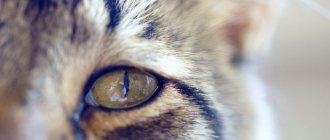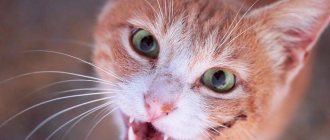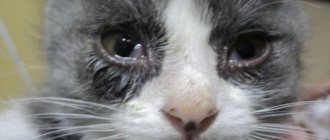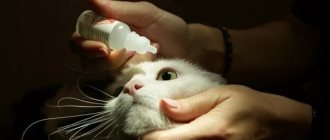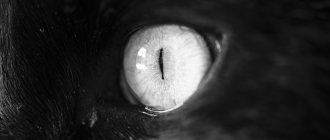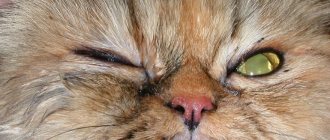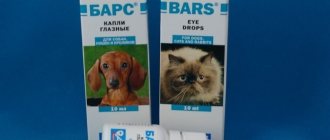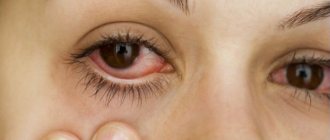What does purulent discharge from a cat's eyes look like?
The purulent discharge from the eyes of a cat is opaque in appearance, has a viscous consistency, and has a yellowish or greenish color, which determines the appearance of the microflora that caused the formation of pus. Depending on the amount of discharge, it can be in the corners of the cat’s eyes, form streaks on his face and dry yellowish crusts, and also form cloudy filmy deposits on the conjunctiva.
The appearance of the eye changes, the most common are:
- redness of the conjunctiva and eyelids;
- swelling of the conjunctiva and eyelids;
- prolapse of the third eyelid on the affected eye;
- blepharospasm - narrowing of the palpebral fissure caused by protective contraction of the eye muscles;
- photophobia - the cat squints the affected eye when in the light, trying to find dark places.
The animal's behavior changes:
- the cat scratches its eyes with its paws and rubs its muzzle against surrounding objects;
- blinks frequently;
- sneezes rarely if this is due to part of the discharge entering the nasal cavity through the nasolacrimal duct, and often if purulent discharge from the eyes is associated with the development of an infectious disease;
- tries to hide in dark places;
- the cat is apathetic, does not want to play, and his appetite decreases.
Purulent discharge is opaque, viscous consistency, with a yellowish or greenish tint
1. Eye burns
In most cases, when something gets into your eyes and causes a burning sensation, no serious harm is caused. Soap, shampoo, and perfume that get into your eyes are not dangerous. In this case, you just need to rinse your eyes with plenty of clean water. The eyes may feel sore and irritated for a while after rinsing, but the symptoms quickly subside.
Chemical burns to the eyes
occur when solid or liquid chemicals enter them, as well as chemical vapors.
Many of them will not harm the eyes if they are quickly washed out of the eyes. Acids (such as bleach or battery acid) and alkaline substances (such as detergents and fertilizers) can cause serious eye damage. The degree of eye burn
is usually determined 24 hours after the incident. In addition to chemical burns to the eyes, chemical gases and vapors can cause severe eye irritation.
Eyelid burn or eye burn
may cause vision problems. Hot air or steam can burn your face and eyes. Fire, explosives - all this is very dangerous for the eyes and for the face in general. In everyday life, eye burns can occur due to bright sunlight, especially when the sun is reflected from snow or water. High-intensity light - from welding equipment, from lamps in a tanning salon - is also dangerous and can cause eye burns.
A must read! Help with treatment and hospitalization!
What diseases can cause your eyes to fester?
Purulent discharge from the eyes is a symptom of both eye diseases and general diseases.
Common diseases accompanied by purulent discharge from the eyes
Common diseases that cause cat eyes to fester:
- Allergy - at the beginning of the disease, the discharge is mucous in nature, bilateral in nature, which changes to purulent with the addition of secondary microbial flora. Additionally observed: sneezing;
- nasal discharge;
- redness of the conjunctiva;
- skin rash.
- instability of appetite;
- panleukopenia: sudden fever up to 40–41 ° C;
- fever;
- fever;
- periodic fever;
- at the very beginning of the disease, the purulent discharge is unilateral, later the second eye is affected;
Chemosis is the predominant symptom when the conjunctiva is affected by chlamydia
- fever;
- sneezing, coughing;
Photo gallery: systemic diseases in which purulent discharge from the eyes is observed
Panleukopenia causes profuse purulent discharge from the eyes and nose.
With herpetic conjunctivitis, the discharge from the eyes is purulent in nature
With chlamydia, purulent discharge from the eyes is typical, as well as chemosis - swelling of the conjunctiva
Measures to improve the condition of the conjunctiva
In case of general diseases, purulent discharge from the eyes is treated only together with the underlying pathology of which they are a symptom. To improve the condition of the eyes in case of general diseases, the following are used as part of complex therapy:
- Regular toilet of the eyes to remove pus and microbial accumulations using hygienic eye lotions: Klini;
- Veda;
- Dewdrop.
- Tsiprovet;
- tetracycline ophthalmic;
- Forvet;
Anandin is a drug that has anti-inflammatory, antiviral and immunomodulatory effects.
Table: eye diseases with purulent discharge
| Type of disease | Symptoms | Treatment |
| Eye injury |
|
|
| Conjunctivitis is an inflammation of the conjunctiva and eyelids, which is unilateral or bilateral. |
|
|
| Keratitis - inflammation of the cornea |
|
|
| Blepharitis - inflammation of the eyelids |
|
|
| Uveitis - inflammation of the choroid of the eye |
|
|
| Entropion is a chronic injury to the surface of the eye by the edge of the deformed eyelid, as well as by its eyelashes. |
| Surgical restoration of the correct position of the eyelid |
| Dacryocystitis - inflammation of the lacrimal sac |
|
|
Thus, purulent discharge from a cat’s eyes may indicate both the presence of a systemic disease and the development of eye disease. Moreover, purulent inflammation can mask the primary nature of the process and return after the use of antibiotics without treating the underlying cause of the disease.
Photo gallery: eye diseases that cause purulent discharge from the eyes
Purulent discharge from the eyes in cats most often occurs due to conjunctivitis.
Keratitis is characterized by clouding of the cornea. Dacryocystitis is characterized by swelling at the inner corner of the eye.
Entropion of the eyelid is treated surgically
Table: drugs that are used to treat eyes in cats with purulent discharge
| A drug | Compound | Operating principle | Application | Price, rubles |
| Ophthalmosan, eye drops |
| Bactericidal, anti-inflammatory, decongestant |
| 185 |
| Leopard, eye drops |
| Antibacterial agent |
Instill 1-2 drops 3-4 times a day for a course of 1-2 weeks. | 159 |
| Ciprovet, eye drops | Ciprofloxacin | Antibacterial agent |
Instill 1 drop 4 times a day for 1–2 weeks. | 196 |
| Tetracycline eye ointment | Tetracycline | Antibacterial agent | Infectious eye diseases caused by pathogens sensitive to tetracycline. Apply 3–5 times a day. | from 44 |
| Maksidin 0.15, eye drops | Germanium bis(pyridine-2,6-dicarboxylate) |
| Treatment of conjunctivitis and keratoconjunctivitis. Apply 1 drop 2-3 times a day for a course of no more than 2 weeks. | 52 per bottle |
Photo gallery for the treatment of eye diseases with purulent discharge
Sinulox is used for systemic antibacterial therapy for infectious eye diseases.
Tetracycline ointment has a broad spectrum of action and is used to treat both bacterial conjunctivitis and chlamydia
Bars eye drops are a combined antibacterial drug with an extended spectrum of action.
Korneregel promotes corneal healing
Maxidin is a veterinary drug that is used for immunocorrection in the fight against diseases of viral origin.
Dekta-2 eye drops are intended for the treatment and prevention of ophthalmic diseases of bacterial origin in pets
Ciprovet for cats is an effective antibacterial drug with a complex spectrum of action.
How to treat a cat's eyes
To carry out treatment procedures, it is better to use the help of an assistant who would hold the cat. If there is no assistant, the cat is immobilized, swaddled in a towel.
The following treatment procedures are carried out at home:
- Eye rinsing: a napkin is moistened with eye lotion or an antiseptic solution and passed over closed eyelids, removing secretions;
- if the eyelids are stuck together, a napkin richly moistened with an antiseptic solution is applied to them and lightly pressed, after which the eye will open, you cannot use force to open the eye, you can damage the eyelids;
- You cannot touch the surface of the eye with a napkin; it is washed with an antiseptic solution from a syringe, after removing the needle.
Since ointments and drops are irritating, it makes sense to wear a protective (Elizabethan) collar on the cat to prevent scratching of the eyes with its paws.
Protective collar prevents paws from scratching your eyes
Video: how to care for your pet's eyes
Rinse the cat's eyes: useful tips
If a kitten's eye is swollen and festering, rinsing should be done carefully, having first taken care of your safety. During the procedure, the pet will be nervous and struggle, so it should be well secured (or use the help of a second person who will hold the animal). The best option is to swaddle the cat with a towel or diaper so that only the head remains outside. Please also adhere to the following recommendations .
- Rinse each eye with solution from a separate container.
- Twist the cotton wool into a tight rope, dip it in a warm broth (medicinal solution), and squeeze it onto the animal’s festering eye.
- When the pet's eyes are completely cleared of purulent discharge, apply tetracycline ointment (1%) under the cat's eyelid. To do this, pull back the animal’s lower eyelid and, using a special spatula, place the composition on its inner surface. Then close your cat's eye completely and massage it lightly. This will help the product to be distributed evenly. To further enhance the effect of using the ointment, preheat the tube with it in your hands. But if the cat is very nervous, then you should not apply the ointment under the eyelid (this can lead to injury to the organ of vision).
© shutterstock
When you urgently need a doctor
A doctor is needed in all cases of purulent discharge from the eyes, when the cause is not obvious, and when purulent discharge persists for more than 2-3 days. In some situations, you should rush to visit the veterinarian, as indicated by the following symptoms:
- the appearance of fever;
- disturbance of general health: lethargy;
- apathy;
- decreased appetite.
You should consult a doctor in all cases where the cause of purulent discharge from the eyes of a cat is not obvious.
What to do: treatment depending on the cause
Treatment is determined by the underlying disease.
Bacterial conjunctivitis
What to drip with? In cases of the development of bacterial conjunctivitis, conservative therapy is mainly used using ophthalmic drops and ointments, including:
- albucid;
- fucithalmic;
- Brulamycin;
- Vigamox;
- okomistin;
- gatifloxacin;
- maxitrol;
- chloramphenicol or tetracycline ointments.
Viral conjunctivitis
What to do if the disease is viral in origin? Antiviral agents will help: oftan idu, ophthalmoferon, okoferon.
The dosage and frequency of use of such drugs depend on the specific pathogen, the severity of the disease and the age of the patient.
Allergic conjunctivitis
If conjunctivitis is caused by allergic reactions of the body, in addition to antibacterial drugs, antihistamines (cromohexal, allergodil, azelastine) are prescribed.
Breed predisposition to purulent discharge from the eyes in cats
Brachycephalic cat breeds are predisposed to the appearance of discharge from the eyes, including purulent discharge. This is due to the structural features of the skull. The nasolacrimal ducts in these breeds are narrowed and curved, which helps to delay the outflow of tear fluid and cause discharge. In addition, the structure of the skull bones predisposes to the presence of chronic inflammation in the upper respiratory tract, which makes it easier for ocular discharge to become infected and become purulent.
These breeds include:
- Persian;
- Himalayan;
- exotic shorthair;
- British;
- Scottish.
Some cats of these breeds require regular help from the owner to care for their eyes in order to prevent the appearance of purulent discharge.
Brachycephalic cat breeds are predisposed to the development of purulent discharge from the eyes
Diagnostics
Diagnostic measures for such disorders include the following :
- blood donation for general and biochemical analysis;
- cytological examination of samples of cellular tissue of the cornea;
- taking a smear with samples of tear secretions;
- eye examination using a slit lamp;
- measurements of intraocular pressure levels;
- keratotopography;
- retinography;
- Ultrasound of the eyes.
Prevention of purulent discharge from the eyes in cats
Measures to prevent purulent discharge from the eyes in cats include:
- regular scheduled vaccinations;
- preventive administration of anthelmintics once a quarter;
- timely detection and treatment of chronic diseases and allergic conditions;
- preventive examinations by a veterinarian;
- protecting the cat from hypothermia;
- exclusion of contacts with stray animals;
- providing quality cat nutrition;
- regular wet cleaning of the premises where the cat is kept;
- Monitoring the condition of your cat's eyes.
Rules for the prevention of infectious eye diseases
Simple measures will help reduce the likelihood of illness:
- strict adherence to hygiene procedures for the face and hands;
- refusal to wear contact lenses during acute respiratory viral infections and other infections;
- thorough cleaning of lenses to prevent pathogens from entering the visual organs;
- avoiding contact with sick people;
- strengthening the immune system through hardening, proper nutrition, and sports.
It is difficult to briefly mention all the infectious diseases that affect the eye. The first thing to remember is that for every infection, treatment measures are required to avoid the development of complications. Therefore, if symptoms characteristic of conjunctivitis, blepharitis and other infectious eye diseases occur, you should immediately contact an ophthalmologist and do not self-medicate.
What can you do before visiting a doctor?
If there is heavy discharge, do not put off going to the veterinarian. Before going to the veterinary clinic, you can relieve your pet's condition by rinsing the eyes yourself.
Until the causes of the disease are determined and adequate therapy is prescribed, the following should be used:
- weak solution of potassium permanganate,
- herbal infusion,
- decoction of tea leaves.
Any of the above products must be cooled to room temperature.
How to carry out the procedure:
- Calm the animal, secure the paws with a towel, wrap the entire body, and lay it on its side.
- Use a pipette or syringe without a needle to drip warm boiled water onto your eyes to soften dried discharge, and gently wipe your eyelids with a swab.
- Moisten 2 cosmetic discs generously in the solution, wipe each eye with a separate disc.
On a note! To avoid infection in a healthy organ of vision, you should take a new cotton pad after each wiping; repeated use is unacceptable.
During treatment, do not bring the syringe or pipette close to the eyes; the kitten may twitch, which will lead to mechanical injury. Processing is carried out from the outer corner towards the inner.
